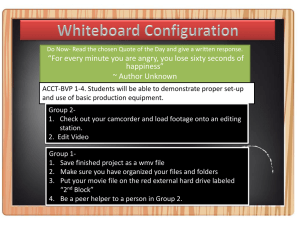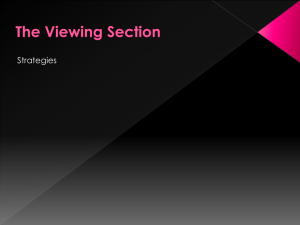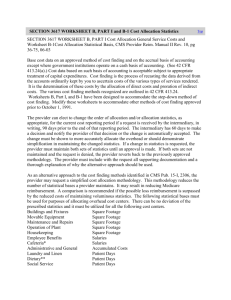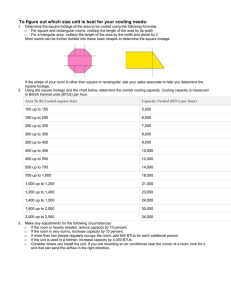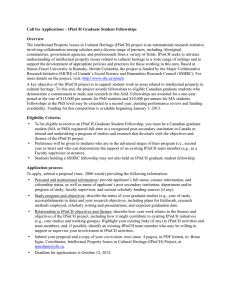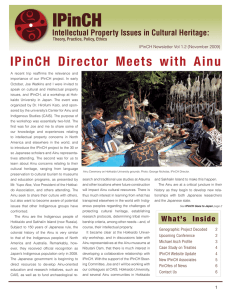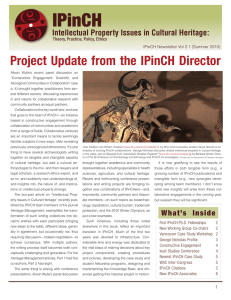USING VIDEO IN RESEARCH & DOCUMENTATION: ETHICAL & IP ISSUES TO CONSIDER FACT
advertisement
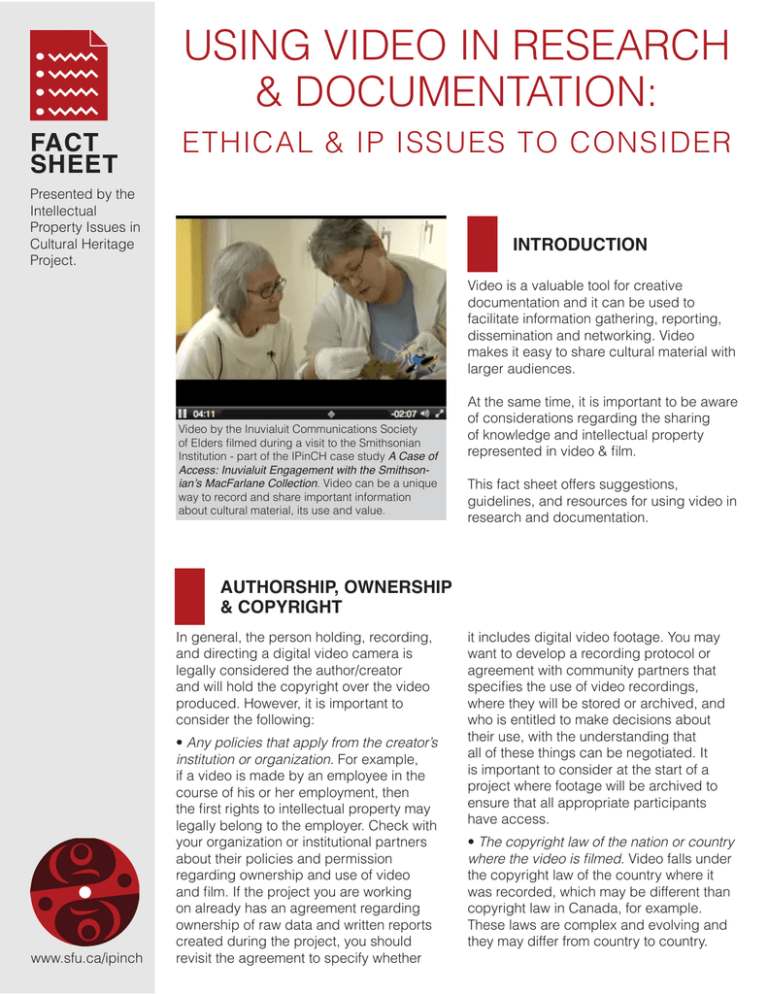
USING VIDEO IN RESEARCH & DOCUMENTATION: FACT SHEET ETHICAL & IP ISSUES TO CONSIDER Presented by the Intellectual Property Issues in Cultural Heritage Project. INTRODUCTION Video is a valuable tool for creative documentation and it can be used to facilitate information gathering, reporting, dissemination and networking. Video makes it easy to share cultural material with larger audiences. Video by the Inuvialuit Communications Society of Elders filmed during a visit to the Smithsonian Institution - part of the IPinCH case study A Case of Access: Inuvialuit Engagement with the Smithsonian’s MacFarlane Collection. Video can be a unique way to record and share important information about cultural material, its use and value. At the same time, it is important to be aware of considerations regarding the sharing of knowledge and intellectual property represented in video & film. This fact sheet offers suggestions, guidelines, and resources for using video in research and documentation. AUTHORSHIP, OWNERSHIP & COPYRIGHT In general, the person holding, recording, and directing a digital video camera is legally considered the author/creator and will hold the copyright over the video produced. However, it is important to consider the following: www.sfu.ca/ipinch • Any policies that apply from the creator’s institution or organization. For example, if a video is made by an employee in the course of his or her employment, then the first rights to intellectual property may legally belong to the employer. Check with your organization or institutional partners about their policies and permission regarding ownership and use of video and film. If the project you are working on already has an agreement regarding ownership of raw data and written reports created during the project, you should revisit the agreement to specify whether it includes digital video footage. You may want to develop a recording protocol or agreement with community partners that specifies the use of video recordings, where they will be stored or archived, and who is entitled to make decisions about their use, with the understanding that all of these things can be negotiated. It is important to consider at the start of a project where footage will be archived to ensure that all appropriate participants have access. • The copyright law of the nation or country where the video is filmed. Video falls under the copyright law of the country where it was recorded, which may be different than copyright law in Canada, for example. These laws are complex and evolving and they may differ from country to country. INFORMED CONSENT When gathering video footage of people, sites or objects for the purpose of research or documentation, it is important to come to an understanding with all those involved about what the potential uses of the recordings are, where they will be stored or archived, and who is legally entitled to make decisions about their use. Video footage that will be posted online may require more extensive conversations about the public nature of the Internet, such as the potential for remix and appropriation, and the difficulty of removing content from the Internet once it has been posted online. Holding an informational meeting to discuss consent and what it means is one way to proceed. Developing a video recording agreement with the community where research or documentation is taking place may be useful to help everyone come to a common understanding. University research projects that involve videotaping humans typically require an institutional research ethics review. Some non-academic institutions, government agencies and community organizations also have research ethics review processes. Evidence of consent for collecting video needs to be explicitly documented, such as in a consent form or letter of agreement that individuals may sign or verbally agree to as participants in research. Ideally provisions will be developed collaboratively with research partners about how and where video footage will be stored or archived and provide contact information for the person managing the collection. FILMING MEETINGS, TALKS, OR GROUP EVENTS Always seek permission from all those present and inform the event organizers before videoing a meeting, a talk, or a planned group event. Notify participants that they have the option not to be filmed and let them know whether they may request edits to the final footage. Be sure to inform those being recorded of any future uses of the video footage. You can gather verbal or written permission, but if you seek verbal permission, make sure it is documented. Make sure to identify by name (or pseudonym) all the people in the recording, in case you need to come back to them for additional permission in the future. POSTING VIDEO TO THE WEB Digital video is easy and direct to upload on YouTube, Flickr, social networking and other publicly accessible sites. Take time to consider the implications of posting media on the Internet. With many sites, simply by posting material, you are implicitly creating a licensing agreement that allows that site to use your material in other ways. Always read the Terms of Use before putting material on these sites. You can lose control of your material very quickly and there is nothing you can do about it. As such, be sure to discuss these considerations with those appearing in the video as part of the consent process. Examples of Licensing/Terms of Use Agreements: • Facebook: Statement of Rights and Responsibilities http://www.facebook.com/terms.php • Flickr: Community Guidelines http://www.flickr.com/guidelines.gne RECORDING PERFORMANCES Be aware that the rules in many countries are much stricter for filming performers and performances than for videotaping people in conversation or activities. Performances are often given a higher level of protection in copyright law, particularly when they involve “traditional cultural expressions” or “folklore.” Such performances may or may not be professional and can include making a speech, dancing, drumming, storytelling, etc. FURTHER READING • Janke, Terri. 2009. Pathways and Protocols: A Filmmaker’s Guide to Working with Indigenous People, Culture and Concepts. Australian Government and Screen Australia (specifically section 3.8 and section 4): www. screenaustralia.gov.au/filmmaking/Indigenous_protocols.aspx • Torsen, Molly and Jane Anderson. 2010. Intellectual Property and the Safeguarding of Traditional Cultures: Legal Issues and Practical Options for Museums, Libraries and Archives. WIPO: www.wipo.int/export/sites/ www/tk/en/publications/1023.pdf This Fact Sheet was developed by the IPinCH Project, with contributions from Jane Anderson, Kelly Bannister, Emma Feltes, Ellen Frankenstein, Kate Hennessy, Julie Hollowell, Jock Langford, Silke von Lewinski, and Douglas Trainor. It was first published in June 2013.
